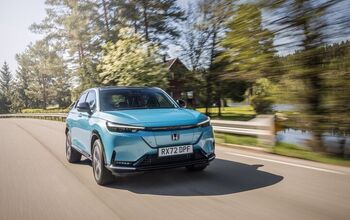BAAM! Printing A Car From Scratch In Six Days

Printing the body of the Local Motors Strati at the rate of up to forty carbon-infused pounds per hour, the BAAM 3-D printer might be the next step in democratizing access to electric cars — or cars of any kind, really.
This isn’t truly a “3-D printed car” as some sources have reported: the wheels came from our friends at fifteen52 and much of the drivetrain was sourced from the Renault Twizy. Still, the speed with which the Strati was constructed offers some fascinating possibilities for homebrew and limited-production automobiles.
I’d be remiss if I didn’t mention the club-racing applications here: imagine being able to order up some 3-D printed fenders for your Spec Miata or World Challenge car after a tough weekend of close running in the pack! Why not throw in some aero enhancements while you’re at it?

More by Jack Baruth

































Comments
Join the conversation
Carbon fiber may be the key to lightweight cars. Not the hand laid aircraft grade but strong enough for auto application. 3D carbon printer ad: https://markforged.com/
Ah yes, home automation: replace a $6 light switch that has 99.999+% reliability and a 40 year service life with thousands of dollars worth of computer hardware and software with Micro$oft reliability and a planned-obsolescence half-life of five years, all to avoid GETTING UP OUT OF YOUR CHAIR AND TURNING A LAMP ON WHEN IT GETS DARK. (Or, why just wait till you're cold and then decide whether to put on a sweater or turn up the heat, when you can have the aforementioned HW and SW try to keep it all comfortable for you? And how well has that worked in any office building you've ever worked in?) But wait, your home automation system can also tell you if you're running low on milk, so you don't have to WALK OVER TO THE FRIDGE AND LOOK (and sniff, has anyone proposed a home automation system that can tell you if the milk's gone bad?). Ah yes, 3d printing - There's a lot of hype that obscures the real and present values and capabilities of this technology, but never sees the light of day in the mass media. I predict a long development curve before the cost of any but the smallest, least loaded final components are made in production by 3d printing. There is much more promise in using 3d printing as an alternate process for patternmaking - this is currently done by stereolithography processes (plus a whole array of older processes, all the way back to wooden patterns), which have their advantages and disadvantages, but the use of 3d printing especially for investment casting is growing by leaps and bounds. But because foundry work is not on the radar screen of the mass media, you'll never hear about this application, where the technology really does offer advantages. Also, you could use 3d printing to form plugs for fiberglass layup, but parts that size would be awful expensive. One exception that I know of to my statement on final components is the production of small quantities of plastic components for model building (like ship models). There's no mechanical load, and purchasers will pay significant money for - say - a superstructure for a model of a destroyer, which would never pay back the cost of an injection mold. There probably are or soon will be other examples. But functional components for a car? Not any time soon.
>>>I’d be remiss if I didn’t mention the club-racing applications here: I was thinking LeMons
And they made it look like that. If they're confident in the strength of their printed car, why is there no roof? I'd be more impressed by something that looks more "car-like" That's assuming that the printing could produce a structural roof.